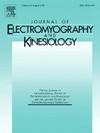日常步态转弯阶段的下肢生物力学与质心控制
IF 2.3
4区 医学
Q3 NEUROSCIENCES
引用次数: 0
摘要
本研究旨在通过分析转弯的接近、转弯和离开三个阶段来阐明日常生活中转弯的生物力学特征。这项研究涉及10名健康的年轻人,他们进行直线行走和90°转弯,分为侧步(SS)和跨步(CS)转弯。利用17个摄像头的运动捕捉系统和测力板,研究测量了关节角度、力矩和质心(COM)的变化。结果表明,转弯包括下肢的旋转运动,分为三个阶段,每一步都有不同的生物力学作用。从COM控制角度来看,SS在出发脚处不稳定性增加,而CS在进近和出发脚处都保持稳定。本研究强调了旋转运动和旋转力在下肢关节旋转中的重要性。它还揭示了质量中心被控制在三个台阶上。这些发现强调了对转弯进行综合分析的必要性,并为转弯时的步态分析增加了新的视角。本文章由计算机程序翻译,如有差异,请以英文原文为准。
Lower limb biomechanics and control of center of mass during turning phases in daily gait
This study aims to elucidate the biomechanical characteristics of turning in daily life by analyzing the three-step process of approach, turn, and departure phases. The research involved ten healthy young individuals performing straight walking and 90° turns, categorized into Side-Step (SS) and Cross-Step (CS) turns. Using a 17-camera motion capture system and force plates, the study measured joint angles, moments, and center of mass (COM) variations. The results indicated that turning involves rotational movements of the lower limbs across three phases, with distinct biomechanical roles for each step. From the perspective of COM control, instability increased at the departure foot in SS, while in CS, stability was maintained at both the approach and departure foot.
This study emphasized the importance of rotational movements and rotational forces in the lower limb joints during turning. It also revealed that the center of mass is controlled across three steps. These findings highlight the need for a comprehensive analysis of turning and add a new perspective to gait analysis during turning.
求助全文
通过发布文献求助,成功后即可免费获取论文全文。
去求助
来源期刊
CiteScore
4.70
自引率
8.00%
发文量
70
审稿时长
74 days
期刊介绍:
Journal of Electromyography & Kinesiology is the primary source for outstanding original articles on the study of human movement from muscle contraction via its motor units and sensory system to integrated motion through mechanical and electrical detection techniques.
As the official publication of the International Society of Electrophysiology and Kinesiology, the journal is dedicated to publishing the best work in all areas of electromyography and kinesiology, including: control of movement, muscle fatigue, muscle and nerve properties, joint biomechanics and electrical stimulation. Applications in rehabilitation, sports & exercise, motion analysis, ergonomics, alternative & complimentary medicine, measures of human performance and technical articles on electromyographic signal processing are welcome.

 求助内容:
求助内容: 应助结果提醒方式:
应助结果提醒方式:


